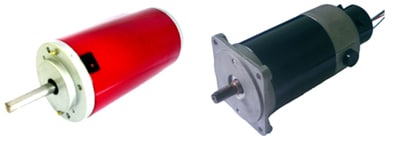Experts say the single most important advance in permanent magnet (PMDC) motor technology was the introduction of neodymium magnetic materials in the mid-1970s. Samarium-cobalt and, to a lesser extent, neodymium has replaced AlNiCo and ferrite materials in many motors. Though neodymium magnets cost more than other types, their increasingly wide acceptance over the past several years has made prices steadily decline.

DC Permanent Magnet Motors
Maximum-energy product (MEP) is used to indicate the relative strength of permanent magnets used in the permanent magnet motors (PMDC). Samarium-cobalt magnets typically run from 18 to 26 MGOe while neodymium ranges from 8 to 35 MGOe. In comparison, the most widely used ferrite magnets only have an MEP of 1.8 to 4.5 MGOe.
Neodymium magnets make for small, lightweight motors with up to 50% more torque than ordinary ones having comparable dimensions. This allows a smaller neodymium motor to do the job of a more expensive and larger conventional unit in permanent magnet DC motors (PMDC). The typical range of torque for both brush-type and brushless dc motors is from 7.0 oz-in. to 4,500 lb-ft.
Neodymium magnets have little rotor inertia because they are light and have small radial dimensions. Flux density is also high. The torque-to-inertia ratio for neodymium brushless motors exceeds that for conventional brushless motors by 250 to 800%. Similarly, torque-to-weight ratios surpass those of conventional types by 40 to 90%, while power-to-weight ratios are from 50 to 200% greater.
Additional improvements to permanent magnet motors (PMDC) have been made to reduce torque ripple. There may be as much as 13 to 17% torque ripple, which causes cogging in switched brushless motors. This effect may be bad for some applications. One alternative is to use a sine-wave drive which has a theoretical ripple of zero (actually 1 to 2%), but sine-wave drivers can cost more than three times as much as switched brushless drivers because they use more complex circuitry.
However, experts say sine-wave drivers are at a point in their development that compares to switched-commutator brushless-motor drivers in the early eighties. Some predict that there will be dramatic reductions in the cost of sine-wave-driven systems over the next 10 years.
Efforts to reduce clogging of brushless DC motors include shaping the back emf to better match the drive signal. Sine-wave drives need a better sine shape to reduce clogging while switched drives need a sharper trapezoid shape.
Another approach reduces ripple by doubling the number of Hall sensors in a six-step commutator. Ordinary commutators typically contain only three sensors. Doubling the number of sensors doubles the commutation cycles (electrical degrees), but keeps the mechanical angle the same without changing the number of poles. This reduces ripple torque to as low as 3 to 5% without changing either the motor or driver amplifier design. A PROM change handles the increased commutation cycles. Doubling the number of Hall encoders dramatically reduces ripple but increases motor cost. Designers now face a challenge to produce cheaper commutating encoders to offset this additional expense.
Sinotech Motors can ensure excellent Permanent Magnet Motors from China, Taiwan and Korea and is very price competitive. Sinotech Motors has manufactured QS-9000 and ISO certified Permanent Magnet DC Motors in China, Taiwan and Korea for over 15 years. Sinotech Motors is dedicated to delivering permanent magnet motors from China, Taiwan and Korea to you at lower prices but the same quality, service and terms as a domestic supplier.
Sinotech Permanent Magnet Motors are engineered in the U.S. and manufactured in China, Taiwan and Korea.
